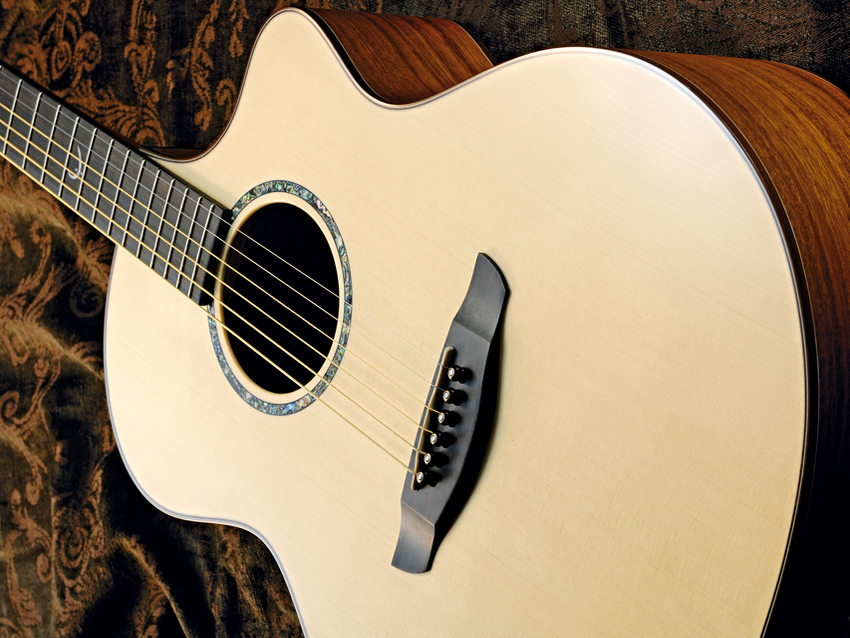MusicRadar Verdict
New body style, new tonewood: it doesn't take a leap of, er, faith to enjoy this successful partnership.
Pros
- +
Class build. Playing ease. Bright and loud acoustic tones.
Cons
- -
Treble can need taming when powered up.
MusicRadar's got your back

Faith Neptune Tremesi

Faith Neptune Tremesi

Faith Neptune Tremesi
With the introduction of the Neptune Trembesi, Faith is in effect presenting a double debut.
The Neptune small-jumbo body style, based on Patrick James Eggle's Saluda, has already figured in the Faith catalogue as one of the two high-end, PJE-made Carolina Series, but it's now being rolled out - in both non-cut and cutaway variants - to the brand's Indonesian-made Natural, HiGloss and Eclipse series.
"The guitar carries a super-clean Engelmann spruce top, and the whole body is stylishly bound in rosewood."
Trembesi, meanwhile, comes on-stream as a new series of its own, covering not only the Neptune, but Faith's other body styles too.
Build
Sometimes loosely referred to as mahogany-like, trembesi is a timber indigenous to south east Asia (and parts of Central and South America) and occupies a distinct genus of its own: Albizia or, as a species, Albizia samanea.
Used for furniture and decorative carvings as well as musical instruments, it goes under a plethora of colloquial local names including the rain or monkey pod tree.
As far as our sample is concerned, the wood does have a vague resemblance to mahogany, but the general appearance, colour and graining are much closer to ovangkol, or even a very light-hued rosewood with a touch of walnut thrown in.
It seems to be a quite light-density timber, as our cutaway Neptune tips the scales at not much over 2kg, which is encouragingly spare considering the guitar's 406mm (16-inch) wide, deepish (117mm) body and the fact that it's loaded with a side-mount preamp system.
With internal rim-reinforcing pieces confirming its all-solid wood construction, the guitar carries a super-clean Engelmann spruce top, and the whole body, with its flat-profile Venetian cutaway, is stylishly bound in rosewood with light wood purfling and coachlinings.
Like Natural series Faiths, the finish comprises a gloss top and satin back and sides, and the trembesi feels evenly smooth to the touch, so is presumably grain-filled prior to spraying.
The launch has provided Faith with the opportunity to introduce a few minor styling tweaks across the range. The wing-ends of the ebony bridge are now slightly rounded, rather than straight-cut at an angle, while the pins - ebony with pearl dots - are arrayed in a slight curve to lessen stress along the grain.
The soundhole rosette's abalone inlay is wider than previously.
Macassar ebony is something of a feature on the instrument. Apart from the bridge, the bound fingerboard, the head-plate and heel-capping are all of this wood, and the buttons on the gold Grover Rotomatic tuners are ebony too, though probably not macassar.
A deft cosmetic touch is gloss-lacquering the heel cap and head-plate, when they could easily have been left satin like the rest of the neck.
This all adds up to an extremely smart, well coordinated presentation, and external woodworking, detailing and finishing are immaculate throughout.
Internally, there are one or two blobs of glue in between the kerfed linings, but the linings themselves are precisely cut and finished, as is the strutting.
Conveniently fitted with a second strap button at the heel, the mahogany neck is attached - as on other Faiths - by a bolting cum mortise-and-tenon arrangement, designed by Patrick Eggle and similar to the Collings approach.
Minimising timber wastage is clearly on the agenda, since not only is the neck scarf-jointed but the boat- bow-shaped heel adds a further four pieces of wood.
With a full 650mm scale length, the neck is of regular span, kicking off at 42.5mm across the Tusq nut, with a snug, shallow, flattish- backed profile that plays fast and slickly.
This is aided by a gentle 'board camber and our sample's faultlessly dressed medium-width fretting and lowish action.
As is the Faith style, the fingerboard is marker-free save for an 'F' motif at the octave, but there's the necessary line-up of side dots. A 55mm string spacing at the bridge comfortably takes care of fingerstyle needs.
Like all Faiths bar Eclipses, the Neptune Trembesi is powered by a Shadow SH863 system, which pairs a Nanoflex under-saddle strip pickup with a simple preamp providing push/push rescissible rotaries for volume and two-band EQ, plus phase and EQ-S buttons, the latter lightly scooping the mids and modestly lifting the bass and treble.
Sounds
Acoustically, the guitar is delightfully articulate and
sustainful, with a fast attack and almost folk-like definition and clarity, added to which is a firm, warmish underpinning and projection endowed by the generous soundbox.
High-end tone is sunnily bright, but arguably a little too zingy until the factory-fitted Elixir strings have been played in. This last aspect is noticeable via the Shadow preamp, which is an inherently bright system.
Initial strums and pickings require some roll-off to avoid an overly crystalline treble, although to what extent depends on the phase and EQ settings. It's really a matter of juggling to taste.
Again though, once the strings are bedded in the whole system assumes an agreeable balance - there's plenty of warmth on tap from the bass band, gain is plentiful and our sample's cross-string output is spot-on. There's definitely much to enjoy here.
In the same way some other makers - such as Mariner with its paulownia and Baden with kanzo - have discovered successful alternatives to traditional tonewoods, so Faith has hit upon a winning choice with trembesi.
Its main attribute, weight aside, seems to be an excellent openness of acoustic voicing, something that suits this small jumbo.
It really is a very desirable, great- playing, well-priced guitar, built to a high standard. In a series context, the Trembesis look to be a significant addition to Faith's already strong, high-value brand image.

"I believe I’ve got the last recording Jeff Beck ever did in the studios": Guitarist Mick Rogers thinks he's in possession of a piece of musical history

“If you want a good vocal, you gotta drink snake sperm”: Singer Jessica Simpson reveals the unusual drink that keeps her vocal cords in tip-top condition

“I was thinking at the time, if anyone wants to try and copy this video, good luck to them!”: How ’60s soul music, African rhythms and a groundbreaking video fuelled Peter Gabriel’s biggest hit










